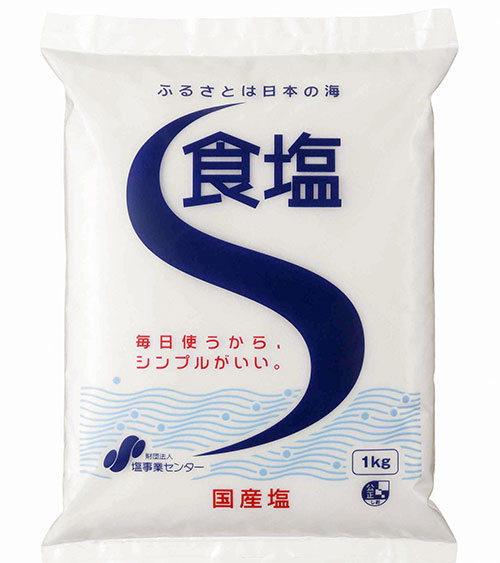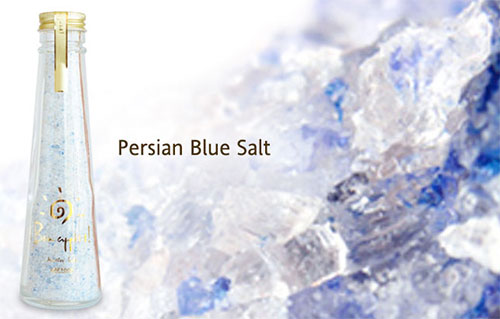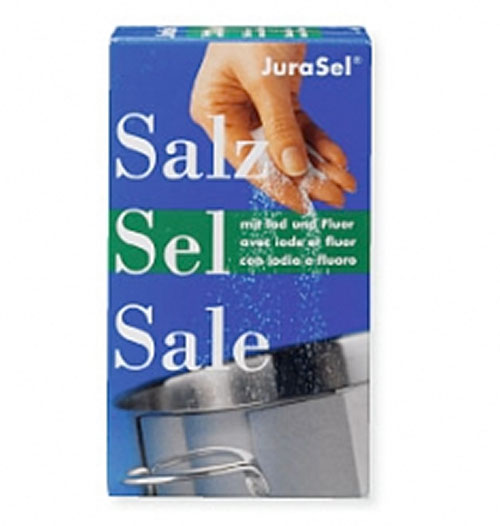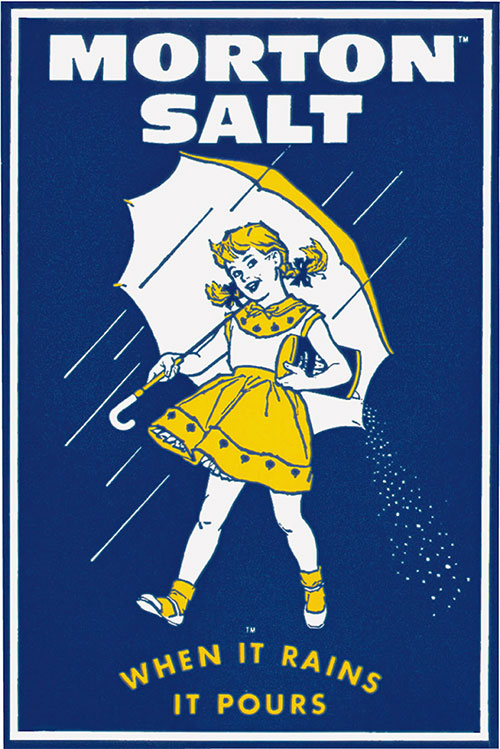Salt, Part 1
(This is Part 1 of a mini-series about that all-important seasoning, salt. It's a continuation in a way of my previous article, about cutting food costs while still eating well. ^_^)
Since I've been able to live in different countries, and stumble my way through different languages and cultures, I have a very cynical view on trendy food and what people claim are "good" or "bad" for you, not to mention what is supposed to taste "better". Why? Because, every country has a different take on things.
Let's take salt. This is a bag of plain old salt in Japan. Salt production and sales used to be controlled by the government (along with tobacco and rice), which is why this bag looks rather plain and government-issue. In any case, it's a good old bag of salt. Japan is surrounded by the sea, so it is sea salt of course. It costs about 100 yen (roughly US$1) for 1 kilo (2.2 lbs).

This is the top selling gourmet salt on Rakuten, the online mega-mall. It is a rock salt called Persian Blue Salt that's imported from Iran. It costs about 4,100 yen (about US$41) for 500 grams (1.1 lb). It's sold with all kinds of claims as to how it tastes so much better than regular salt because it has the umami of "ancient plantlife from primordial oceans trapped in rocks for millenia" and the like. Rock salt in general in Japan is held to be superior, better tasting, and so on than sea salt, except for extra-special types of sea salt like fleur de sel from the Guerande in France.

Not coincidentally, Japan has no salt mines, so all rock salt is imported, and is therefore a rarity.
This is a box of JuraSel. It's the most popular brand of salt in Switzerland - a landlocked country. This rock salt comes from the salt deposits in the Rhine valley, that formed during the Jurassic period. It costs .75 CHF (about 85 US cents) for 500g (1.1lb).

Which means that of course, sea salt is considered to be far superior for gourmets than rock salt in Switzerland.
Conclusion? Don't believe the marketing. What is exotic and special where you live is most likely just ordinary somewhere else.
It's not the source, it's the refining method and shape of the crystals
Salt is mostly sodium chloride. The much maligned table salt or 'just plain salt' is actually more refined than most 'gourmet' salts, to remove as much of various impurities in the salt as possible, leaving just the sodium chloride. It's also further processed so that it 'flows' easily, especially when it's humid. Hence, the famous Morton Salt slogan, "When it rains it pours".

Table salt has become maligned in the last decade or so for being too 'harsh'. But the thing is, when you are using salt for cooking, together with lots of other flavors, there is absolutely no need to use a fancy "gourmet" salt. You just want to add a salty flavor and all those extra flavors in the "gourmet" salt will just get lost.
The reason why fancy salts taste different is because of two things: First, they are not as refined as regular salt, so various impurities remain, whether they are from current day sea or primeval seas or whatever. That's also why a lot of fancy salts are grey, or pinkish, or blue-ish.
The other reason is the shape of the salt crystals. Table salt has square crystals, which flow better. Fancy salt has bigger, irregularly shaped crystals. The most famous fancy salt with big crystals is probably Maldon salt, which is produced in Essex, England. Maldon salt has big, thin crystals, which melt gently on the tongue. Fleur de sel is produced in various regions, but the most famous one comes from the Guerande region of France. Fleur de sel (which means 'flower of salt') has soft, fluffy crystals, which also melt gently on the tongue.
These salts may be worth using in dishes where the salt is on the surface of the food. Salads in particular benefit from the use of such salts with gently melting crystals. Or if you are grilling meat or fish, or vegetables, and you sprinkle the salt on the surface. But using these really expensive salts in stews and such is pretty much a waste of money.
What I use
As I mentioned in my last article, we're watching our food budget a bit more these days. While something like salt may seem trivial, when one type costs 10-20 times or more than the other, it does make a difference. Fleur de sel is not that expensive here in France (there are even generic supermarket-branded versions of fleur de sel de Guerande but still, it's much more expensive than ordinary salt of course.
We use 3 types of salt in our house:
- Regular salt for salting pasta water, in soups and stews with lots of other flavors. Note that you need to use a bit less of regular salt than the less refined salts, since it's well, saltier.
- Coarse "grey" salt on things like grilled meat, roast chicken, etc. It adds a little extra flavor.
- Fleur de sel on salads and things like sliced ripe tomatoes with a drizzle of olive oil.
Note: Personally, I am not fond of seasoned salts with herbs and dried tomatoes and lemon peel and the like in them. I prefer to use my own other-flavors in conjunction with salt.
If you enjoyed this article, please consider becoming my patron via Patreon. ^_^

 Welcome to Just Hungry, where we serve authentic Japanese recipes and more! I'm
Welcome to Just Hungry, where we serve authentic Japanese recipes and more! I'm 











Comments
Stacey
16 April, 2014 - 23:48
Permalink
Re: Salt, Part 1
What an interesting article, and it reminded me of my time living in Japan, way back in the 1980's. I could not read Japanese, and I had to go by best guessing for some of my food purchases, thus ending up with flour instead of salt. I went to another supermarket and still could not find any salt. I knew the word, and asked where it was. A kind clerk walked with me out of the store and down the street to an utterly nondescript store which did, in fact, sell the government-controlled salt. Talk about great customer service!
Grace Mccarter
17 April, 2014 - 00:47
Permalink
Re: Salt, Part 1
That's super interesting! I always liked the subtle difference of the pink Himilayan salt I've been buying for years as opposed to the table-salt but always wondered what made that change! Interesting read!
Zarina
17 April, 2014 - 11:06
Permalink
Re: Salt, Part 1
Thank you so much for this enlightening article! Actually I have been thinking about different types of salt lately - not knowing if I should simply buy regular salt, regular salt plus iodine and folic acid, or those fancy salt things (like fleur de sel or something called pyramid salt).
This has cleared it up for me, and made me realize that I don't need to buy (regular) sea salt (I'm in Germany). So thank you very much! I might try out one of these fancy salts (is there even a plural?), but now I'm in no hurry :-)
alia
17 April, 2014 - 19:45
Permalink
Re: Salt, Part 1
Iodized salt isn't about flavor, it's about avoiding iodine deficiency, which can affect thyroid function. In most food grown on land, iodine levels are negligible, although this depends on where the food is grown. Seafood has some of the highest concentrations of iodine naturally, so if you eat a lot of seafood (and some seaweeds) you probably don't need to worry about iodine deficiency. Otherwise, it might be worth looking into whether food grown in your country has iodine or not (it depends on soil concentrations).
One thing I found weird in Germany was the fluoride in some table salt. Why on earth would you want to add fluoride to your diet?
anon.
18 April, 2014 - 03:21
Permalink
Re: Salt, Part 1
fluoride is good for one's teeth. it's put in public water sources in some cities in america.
Myxini
18 April, 2014 - 04:31
Permalink
Re: Salt, Part 1
in the US most places add fluoride to the municipal water supply, in other countries they add it to the salt. Fluoride supplements in children contribute to stronger tooth enamel and reduce the incidence of cavities (up to a point, if there's too much the teeth turn brownish). It's like why there's fluoride in toothpaste, but it's a stronger effect if it's ingested in kids, while the adult teeth are still forming. and because it's hard enough to get people/kids to do anything that's good for them, they just put it in the water supply or salt.
Quinn
17 April, 2014 - 16:03
Permalink
Re: Salt, Part 1
I've read that regular iodine salt is not good for health, rather we should consume iodine from seafood, seaweeds and sea salt. Rock salt is slightly more dehydrating than sea salt due to the moisture content of the salt. Processed salt usually contain anti-caking agents which are not good for health, so I personally avoid them.
Dillon
17 April, 2014 - 16:21
Permalink
Re:Salt, Part 1
That is true, but don't forget that table salt also has anti caking additives. Some are natural and wont hurt you (unless you have an underlying health condition of the liver or kidneys) and some are chemical and definitely not that great for you (think of Sodium aluminosilicate). We check all our salt labels to make sure they are additive free. Not only that, but table salt is highly processed to strip the mineral content from it (usually with chemicals). We make sure to get salt that is processed as little as possible - which is hard sometimes T.T Good thing though, we use less salt now because of this so it's a win-win in our home. Oh, some breads (like at subway) contain known carcinogens - we now make our own T.T Well, I make it. We eat less bread now too, lol.
suz
17 April, 2014 - 16:34
Permalink
Re: Salt, Part 1
Thank you for clarifying the distinctions and uses of salt. This was gratefully informative.
John Corbally
17 April, 2014 - 16:46
Permalink
Blood Pressure and Salt
Alas, once I zoomed past fifty (and had teenagers at the time), my blood pressure started creeping up. I had always had rather low blood pressure, but both of my parents were on BP medication in their later years.
Consequently, I now have lowered my salt intake dramatically. This has two effects: 1) I MISS SALT! 2) when I add a very little salt, I REALLY notice it. When I watch cooking shows, I notice the chefs tossing in "A little salt," which is actually a fist-full of kosher salt, and I go a little cross-eyed and recall that I used to do the same thing.
I DO NOT like salt substitutes. Do you have any advice on which sort of salt might be most satisfying while not requiring a huge amount to be added for flavor?
Morgan
27 April, 2014 - 22:26
Permalink
Re: Blood Pressure and Salt
Try to stuff as much non-salt flavor into the food when you're cooking, spices, herbs and non-salt marinades. When its time to eat lightly sprinkle salt onto your portion, I think a good flake salt or kosher salt would be better than table salt, right before eating. Your tongue will be greeted with a spark of salt, without using to much. And you're right, all the fake salts are horrid tasting.
Dosirakbento
17 April, 2014 - 16:47
Permalink
Re: Salt, Part 1
Thanks for this interesting article.
I like to use quite a bit of salt, but with some salts you don't actually need that much!
*heidi*
17 April, 2014 - 17:18
Permalink
Re: Salt, Part 1
Very true! In fact some highly-colored salts on the market were later found to be rather potent in substances we don't really want to ingest.
Does Morton's still contain additives to facilitate 'pouring?'
Here we use either coarse or fine-ground sea salt of a light grey color. We like the taste and trace mineral content. Maldon also makes an appearance in shiozake and similar preparations, because of its own qualities of shape and taste.
Hope you are feeling better with the coming of Spring dear Maki!
Alia
17 April, 2014 - 19:39
Permalink
Re: Salt, Part 1
A few months ago I came across a store that sold over 100 regional salts. (The owner is a food writer that wrote a book on salts, incidentally.) I tried a few (probably more than I should have, my tongue got pretty dried out) and can confirm that they do have subtly different flavors. But some of them also have subtle amounts of stuff like uranium, so maybe not something that should be in the everyday diet, anyway. (Take note, fans of pink Himalayan sea salt!)
I ended up buying a Japanese deep sea salt and it was pretty delicious sprinkled on food right before eating. But I definitely wouldn't use it on something where it'd get dissolved and mixed in.
Wagashigrrl
18 April, 2014 - 00:01
Permalink
Re: Salt, Part 1
I'm not a salt gourmet, but like most people, I have containers of various salts. The blue salt is beautiful. I wonder how it is prepared. I will have to grab some next time I'm in our local Asian town.
Just remember to not use iodized salt if you are preparing vegetables for fermenting.
Anna
18 April, 2014 - 00:50
Permalink
Re: Salt, Part 1
a few thoughts on the article and comments:
i don't think high salt is as much of an issue--recently the NIH in the US revised their stance on it and studies showing that minimizing salt intake can actually hurt people.
i love that Wagashigrrl pointed out not to use iodized salt for pickling! this is very important.
i personally use cheap bulk sea salt for pickling and every day use (usually a 4 kg or 10 lb bag, i keep most of it in a tightly sealed container as it's hydroscopic and only take out a bit at a time). this is because i think it tastes good, it's cheap, and i'm lazy about other salts (and now iodized and kosher salts don't do it for me--i guess i like the impurities and i really do notice a difference).
maldon smoked sea salt is a wonderful pantry item, especially for those without outdoor bbq/smoker/grill space.
i recently got some himalayan salt, out of years of curiosity when i saw it at a local desi grocer--it was much cheaper than in American hippy-marketed grocers. i have not noticed a big difference in flavor, i don't think i will use it except for it's texture. it's rather fine and because my daily sea salt isn't, it will be nice on stuff like popcorn, griddle-pan meats/veg, and garnishing in general.
i also think the relative marketing of salt is both amusing and a good warning to consumers. i do see mined salt as having a greater environmental impact, so i theoretically favor sea salt (where it's already part of the water cycle)---of course i am also concerned about pollution (not sure how seriously i take either of these points). salt does have such an interesting history--as an item of trade, as an item to be regulated and taxed, etc.
Ken
18 April, 2014 - 02:12
Permalink
Re: Salt, Part 1
Thanks for the great article. Salt is salt no matter whether it comes from the sea or the mine. I've been telling my students for years that so-called gourmet salts are just a marketing scheme. Suggestions that certain salts contain trace minerals necessary for good health is misinformation (does anyone realize just how much salt you would have to consume to get any benefit from the trace minerals in salt???) You are correct in mentioning that it is the size and shape that make the difference in how we perceive the taste. We also need to be aware of the "hidden" salt in foods that are highly processed.
On the subject of BP I've found that MSG (oh crap! Now I've opened a can of worms!) is a good adjunct to minimize salt consumption. Problem is that most people think you need to use a lot to make the flavors stand out. All you need is 1/8 tsp. (a pinch) . Adding more than that will not have any benefit. (And before anyone writes to claim that using MSG is bad for you, if you eat any processed food you claim is null as most, if not all ,highly processed foods contain MSG and it does not have to be listed in the ingredient panel if the processor purchased an ingredient from an outside source to make their product.)
Lynn
18 April, 2014 - 07:05
Permalink
Re: Salt, Part 1
Thanks for the very interesting post!
I have to admit that in the past,
I bought into the gourmet salt ideas.
I had Hawaiian Sea Salt, Himalayan Salt, salt from France and Australia, and several seasoned salts.
I imagined that they all tasted different in dishes that I cooked. But later, in a moment of truth, I realized that I really couldn't tell a difference between any of them, except for the smoky-flavored salt.
I just love the idea of making a culinary difference with unique kinds of salt, but sadly, I don't think it is so.
Thanks,
Lynn
Anna
18 April, 2014 - 13:05
Permalink
Re: Salt, Part 1
I currently live in Korea and often see "roasted salt" in bags at the grocery store. It looks like regular ol' salt to me. Is there a similar Japanese product?
susanne
20 April, 2014 - 14:02
Permalink
Re: Salt, Part 1
Unfortunately, they only sell the salt with added iodine/fluoride in Switzerland for a cheap price (this is kind of an old picture though).
In Switzerland, only one company has the exclusive right for producing salt, thus it cost about everywhere the same price http://www.jurasel.ch/
(check "Produkteübersicht", this contains the variety of products they are selling, Jod = iodine, Fluor = fluoride, Speisesalz/Tafelsalz = salt for food)
This monopole is called salt right (droit de régale). All salt imports are heavily taxed, even the bath salts...
I pay 0.95 CHF for 1 kg for Jura-Sel conta(m)in(ated) with iodine, sometime including fluoride.
The 1/2kg box without aditions costs 0.70 CHF online (I haven't seen it in stores though, not even the big ones!).
For 1 kg regular sea salt I have to pay 2.70 CHF.
But all the salt in bought food contains iodine, like in baked stuff, convenient food etc. This is probably the same in other countries too.
Fortunately, our tap water doesn't contain fluoride as the one in Basel.
I'm not really fond of all this additions to the food I eat!
anon.
28 April, 2014 - 23:41
Permalink
Re: Salt, Part 1
Thank you for this great post, Maki. I was wondering if there was any real benefit to the upscale salts like Himalayan pink salt. I'm looking forward to Part 2.